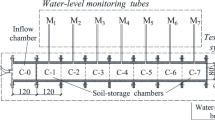Although internal erosion causes serious hazards to embankments and dams, studies on the emission of fine soil particles and the development of non-uniform penetration of the soil foundation after suffusion do not go far enough. Given that suffusion development is random and complex, this study employed self-designed equipment to conduct tests under specific conditions. Twelve samples with three different pore size distributions were used to make a comparative analysis on aspects such as piezometric head, flow rate, coefficient of permeability, trend of fine particles, and accumulated sand emissions. Furthermore, the coefficient of permeability, void ratio, movement trend of fine particles in samples, and changes in content of the remaining fine particles were studied. Combined with theoretical calculations, correlations among the movement trend of fine particles in the samples, content of remaining fine particles and uneven changes in the permeability coefficient were shown. Using the relationship between permeability and porosity, we derived a theoretical formula was deduced from the changing amount of accumulated sand emissions over time under fixed upstream total head.
Similar content being viewed by others
References
Chang-xi Mao, Xiang-bao Duan, Jin-bang Cai, and Hai-ying Yu, "Experimental study and analysis on piping of levee in Beijiang River," J. Hydraul. Eng. (2005).
Chang-xi Mao, Xiang-bao Duan, Jin-bang Cai, and Jian-hui Ru, "Experimental study on harmless seepage piping in levee foundation," J. Hydraul. Eng., 11, 46-53 (2004).
Yue Liang, Jiansheng Chen, and Liang Chen, "Mathematical Model for Piping Erosion Based on Fluid- Solid Interaction and Soils Structure," GeoHunan Int. Conf., 109-116 (2011).
Exequiel Sinco, Xiao Ming, Louay M. Owaidat, and Larry Smith, "Slurry Induced Piping Progression of a Sand," Int. Conf. Scour and Erosion 2010, ASCE, 408-417 (2010).
Xiao M. and Gomez J., Effect of piping on shear strength of levees, Geoenvironmental engineering and geotechnics: progress in modeling and applications, " Proc. of Sessions of GeoShanghai 2010, Shanghai, China, 3-5 June, 51-56 (2010).
Jian Zhou and Kai-min Zhou, "3D Modeling of Piping Mechanism Using Distinct Element Method, GeoShanghai Int. Conf. 2010 (2010).
K.S. Richards and K.R. Reddy, Experimental Investigation of Piping Potential in Earthen Structures, Geocongress 2008: geosustainability and geohazard mitigation (2008).
M. A. Koenders and J. B. Sellmeijer, "Mathematic Model For Piping," J. Geotech. Eng., 118:943-946 (1992).
R. Fell, Chi Fai Wan, J. Cyganiewicz, and M. Foster, "Time for Development of Internal Erosion and Piping in Embankment Dams," J. Geotech. Geoenviron. Eng., 129, 307-314 (2003).
Jiansheng Chen, Xinwen Li, and Weibing Zhao, "Study on piping leakage mechanism," J. Hydraul. Eng., 9, 48-54 (2000).
Jian Zhou, Zhixiong Yao, and Gang Zhang, "Research on piping mechanism in sandy soils based on discrete element theory," J. Rock Mech. Eng., 4, 749-756 (2008).
Zhou Jian, Yao Zhixiong, Bai Yanfeng, and Zhang Jiao, "Meso-mechanical Study on Piping in Sandy Soils," J. Tong ji Univ. (Nat. Sci.), 36, 733-737 (2008).
Jian Zhou, Zhi-xiong Yao, and Gang Zhang, "Meso-laboratory Study on Initiation and Evolution of Piping," Chin. J. Undergr. Space Eng., No.5, 842-848 (2007).
Guang-xin Li and Xiao-jie Zhou, "Laboratory simulation on generation and evolution of piping in embankment foundation," Adv. Sci. Technol. Water Resour., No.12, 21-24 (2005).
Wo-hua Zhang, Gong-shuan Yu, and Yuan-qiang CAI, "Mechanism model and artificial intelligence method for prediction and judgment of piping occurring in embankment," Zhejiang Univ. (Eng. Sci.), 7, 902-908 (2004).
L. MeDowell-Boyer, J.R. M-Hunt, and N. Sitar, "Particle transport through porous media, "Water Resour. Res., 22(13), 1901-1921 (1986).
C.S.P. Ojha and V.P. Singh, "Determination of critical head in soil piping, J. Hydraul. Eng.," 129, 511-518 (2003).
P.A.Cundall, and O.D.L. Strack, "A discrete numerical model for granular assemblies," Geotechnique, 29, 47-65 (1979).
Yue Liang, "Reseaches on the charasticstics of pore flow in seepage field and the mathmatical models of piping erosion," PhD diss., Hohai University, Nanjing, China (2011).
Jie Liu, Seepage stability and seepage control on soil in Chinese, Monograph, Beijing, China (1992).
Author information
Authors and Affiliations
Additional information
Translated from Osnovaniya, Fundamenty i Mekhanika Gruntov, No. 3, p. 30, May-June, 2015.
Rights and permissions
About this article
Cite this article
Chen, L., Zhao, J., Zhang, H. et al. Experimental Study on Suffusion of Gravelly Soil. Soil Mech Found Eng 52, 135–143 (2015). https://doi.org/10.1007/s11204-015-9319-7
Published:
Issue Date:
DOI: https://doi.org/10.1007/s11204-015-9319-7




